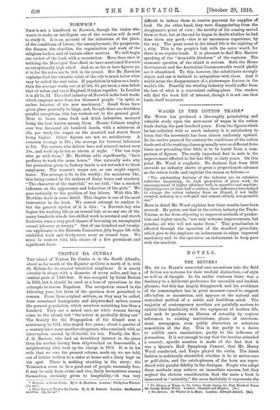WAGES IN THE COTTON TRA.DE.* Mn. WOOD has produced a
thoroughly painstaking and valuable study upon the movement of wages in the cotton trade during the past hundred years. From the figures which
he has collected with so much industry it is satisfactory to learn that the movement has been almost uniformly upward. In the earlier years of the century the conditions of the cotton
trade and of the working classes ganerally were so different from those now prevailing that little is to be learnt from a com-
parison of figures. The really important fact to note is the improvement effected in the last fifty or sixty years. On this point Mr. Wood is emphatic. He declares that from 1850 onwards no industry shows so great a proportionate advance as the cotton trade, and explains the reason as follows :—
"The outstanding features of the industry are its extensive collective bargaining, its high proportion of piece work, its encouragement of higher efficiency both in operative and machine. Operating over at least half a century, these influences have helped to change the cotton industry from an ill-paid, if not badly sweated, industry to a well-paid and almost entirely non-parasitic one."
More in detail Mr. Wood explains how these results have been secured. He points out that in the cotton industry the Trade- Unions, so far from objecting to improved methods of produc- tion and higher speeds, "not only welcome improvements, but penalise all who will not make them." This penalisation is effected through the operation of the standard price-lists, which give to the employer an inducement to adopt improved machinery and to the operative an inducement to keep pace with the machine.














































 Previous page
Previous page